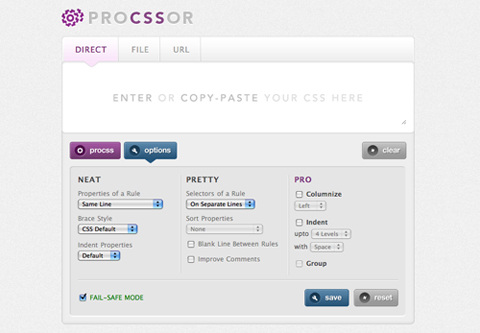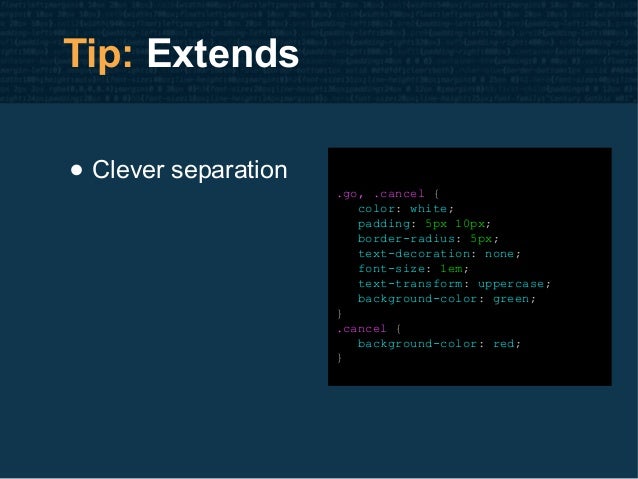

LESS Less runs inside Node Javascript, in the browser.

This is nice if you’re borrowing something from CSS, and it’s clean and well written, and it’s not in your best interest to take the time to re-write everything.

SCSS is fully CSS compliant, meaning you can import regular CSS into a SCSS file, and it will work immediately. SCSS SCSS is like Sass, but is closer to regular CSS. The styles will appear at the location of any directives found within the mixin. With it is possible to pass a block of styles to the mixin for placement within the styles included by the mixin. lets you use media queries right inside of the nesting allowing you to target specific screen sizes. A few differences Sass has versus LESS and Stylus are and lets you share a set of CSS properties from one selector to another. Sass also has great mixin libraries such as Compass and Bourbon. The differences (the 20%) Sass Sass was built on Ruby and has frameworks like Gumby and Foundation. All three let you abstract key design elements, use logic and write less code, which makes them all able to give you an advantage over basic CSS. All three preprocessors allow you to create variables, media queries, mixins, nesting, loops & conditionals and importing. The other 20% is made up of minor differences in the advanced usage. Each CSS preprocessor has its own unique way of accomplishing the same task, even though about 80% of Sass, LESS and Stylus are the same. What is the difference between popular preprocessors? Sass vs LESS vs Stylus There are three main preprocessors – Sass, LESS and Stylus.
#CSS PROCSSOR CODE#
This advanced code is later compiled as normal CSS code that the browser will understand. It offered an advanced way of writing CSS that extends the basic functionalities. To overcome most of these limitations, the concept of a preprocessor was created. Using only CSS, the designer/developer is not able to reuse a collection of rules in multiple selectors which had unclear pieces of data across a stylesheet. A browser can only understand CSS, which at times may not be enough to write clean and reusable rules. You don’t need to take the whole package (even though you can) but rather you can customize it, modify it and create almost a whole new resource pack.What is a CSS Preprocessor? A CSS preprocessor is a scripting language that extends CSS and is compiled into regular CSS syntax. One of the main differences when it comes with PostCSS is the fact that it’s modular. Almost like an underdog, it’s one of the biggest and best alternatives to the SASS, LESS and Stylus. PostCSS is one of the big contenders on this list. Furthermore, you don’t require curly brackets to create code blocks because Stylus utilizes indentations instead of symbols to do so. The versatility of Stylus is its first and primary feature: colons, semicolons, and commas are all optional. It’s built just with that, and if you’re familiar with the environment, Stylus is the CSS preprocessor for you. Launched in 2010, Stylus has a smaller user base than the former two, but still a great contender, especially for those who are familiar with Node.js. When looking at its functionalities, we can see that it has most of the same features as SASS, just under a different name, including different functions and mixins. It’s reliable, it has a smooth learning curve since it’s syntax is very similar to plain CSS. It’s still one of the older ones on this list, launching in 2009. LESS is what we use here at EMOTIONstudios, so we can safely say that it’s our favourite on this list. Sass is easy to install, set up and learn on the go, given the fact that it has a great community and support forum. SASS has tons of features, like rules (like functions in a way) and built in modules, a more than large support community, and is even at the foundation of Bootstrap, so no wonder why it’s the most popular at this moment. SASS is the most mature, most stable and powerful extension language that’s on the market, and with more than 15 years since its release in 2006, it’s hard to contest that. The one, the only, the king among preprocessors. I would rather talk right now about the best CSS preprocessors in 2021. I could give you 6 reasons to use a css preporcessor anyday, but that’s quite the old topic.

You know, the things that are workarounds to CSS’ limitations and give you extra functionalities (like mixins) that can help with scalability and efficiency.
#CSS PROCSSOR PROFESSIONAL#
All the cool, I mean, professional developers use preprocessors these days. CSS? That old, boring thing? Nobody uses plain CSS these days.


 0 kommentar(er)
0 kommentar(er)
